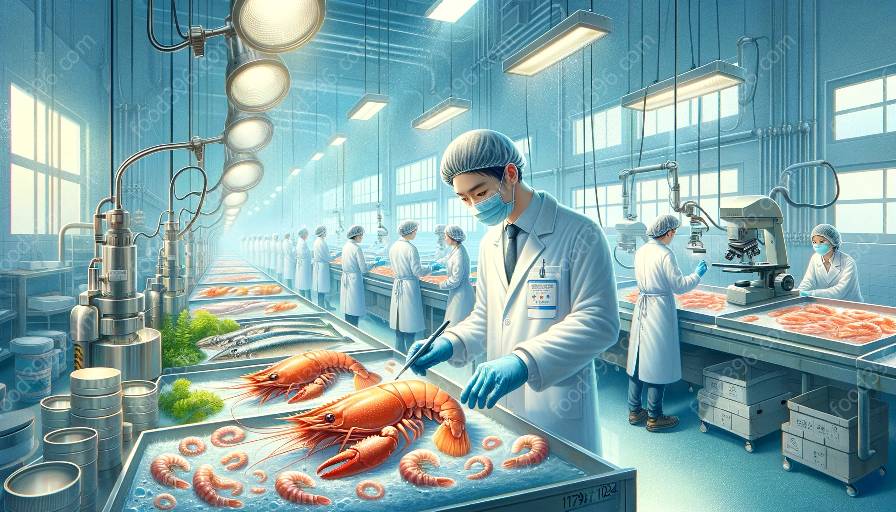Seafood is a vital component of many people's diets across the world, with its quality being of utmost importance. Sensory evaluation and organoleptic analysis are crucial processes in determining the quality of seafood products. These methods involve the assessment of sensory properties and characteristics, such as appearance, flavor, aroma, texture, and overall consumer acceptance. In this topic cluster, we will delve into the principles, methods, and significance of sensory evaluation and organoleptic analysis in the context of seafood quality, covering aspects that align with seafood safety and sanitation, as well as seafood science.
Sensory Evaluation of Seafood
Sensory evaluation is a scientific discipline used to evoke, measure, analyze, and interpret responses to products perceived through the senses of sight, smell, touch, taste, and hearing. In the context of seafood, sensory evaluation plays a critical role in gauging product quality and consumer acceptance. It involves trained sensory panels or consumers evaluating seafood products to assess attributes such as appearance, color, texture, flavor, and overall liking.
Importance of Sensory Evaluation in Seafood Quality
The quality of seafood is influenced by various factors, including species, handling, storage, processing, and cooking methods. Sensory evaluation allows for the detection of any changes in seafood quality, including off-flavors, rancidity, and texture alterations. Furthermore, it provides valuable feedback for seafood processors and suppliers, enabling them to make improvements and ensure consistency in product quality.
Methods of Sensory Evaluation
There are several methods of sensory evaluation, including discrimination testing, descriptive analysis, consumer testing, and preference mapping. Discrimination testing helps to determine whether there are perceptible differences between samples, while descriptive analysis involves trained assessors providing detailed descriptions of sensory attributes. Consumer testing, on the other hand, involves assessing the preferences of the target consumer group, while preference mapping identifies the key factors driving consumer preferences.
Organoleptic Analysis of Seafood
Organoleptic analysis refers to the examination and evaluation of sensory properties through human senses, providing information about the quality and palatability of foods, including seafood. This analysis involves considering the appearance, odor, texture, and flavor of seafood products to assess their overall quality and freshness.
Parameters Assessed in Organoleptic Analysis
Organoleptic analysis of seafood involves evaluating various parameters, such as color, translucency, odor, firmness, and taste. These parameters provide insight into the state of the seafood product, allowing for the identification of any off-putting characteristics or signs of spoilage.
Integration with Seafood Safety and Sanitation
When conducting organoleptic analysis, it is essential to consider the aspects of seafood safety and sanitation. This involves ensuring that the seafood products being analyzed meet all relevant food safety standards and have been handled and stored in a manner that prevents contamination and spoilage. Any deviations from these standards can be identified through organoleptic analysis, thereby contributing to the overall assurance of seafood safety and quality.
Seafood Safety and Sanitation
Seafood safety and sanitation are crucial aspects of the seafood industry, encompassing measures to ensure that seafood products are free from harmful pathogens, contaminants, and spoilage. These measures are essential for protecting the health of consumers and maintaining the overall quality of seafood products.
Regulatory Standards for Seafood Safety
Regulatory bodies, such as the Food and Drug Administration (FDA) and the European Food Safety Authority (EFSA), have established stringent standards and regulations for seafood safety. These standards cover various aspects, including hygiene, temperature control, and prevention of cross-contamination, to minimize the risk of foodborne illnesses associated with seafood consumption.
Role of Organoleptic Analysis in Seafood Safety
Organoleptic analysis contributes to seafood safety by enabling the early detection of sensory abnormalities and signs of spoilage in seafood products. By identifying off-flavors, off-odors, and other undesirable characteristics, organoleptic analysis plays a critical role in preventing the consumption of potentially unsafe seafood products, thus supporting overall seafood safety and sanitation efforts.
Seafood Science and Quality Assessment
Seafood science encompasses the multidisciplinary study of seafood products, covering aspects such as processing, preservation, quality assessment, and consumer preferences. It plays a significant role in the development of innovative seafood products and the improvement of seafood quality and safety.
Application of Science in Sensory Evaluation
Science plays a key role in the development and refinement of sensory evaluation methods for seafood. By utilizing scientific principles, researchers and sensory professionals can enhance the accuracy and reliability of sensory assessments, leading to more precise evaluations of seafood quality and consumer acceptance.
Advancements in Seafood Quality Analysis
With ongoing advancements in analytical methods and technology, seafood quality analysis has become more sophisticated and precise. Techniques such as chromatography, spectroscopy, and molecular biology have been applied to assess the chemical composition, freshness, and safety of seafood products, contributing to the overall understanding of seafood quality and safety.
By understanding the principles and applications of sensory evaluation and organoleptic analysis in seafood quality, as well as their integration with seafood safety and sanitation and seafood science, stakeholders in the seafood industry can make informed decisions to ensure the production of high-quality, safe, and palatable seafood products that meet consumer expectations and regulatory standards.

